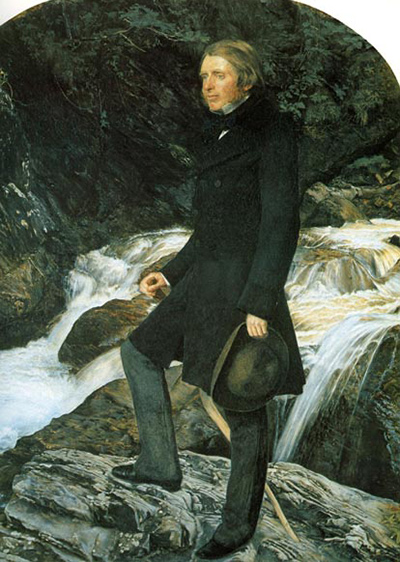John Everett Millais was a famous Pre-Raphaelite artist who painted the now iconic self portrait of his friend and art critic, John Ruskin. It was painted between the years 1853 to 1854.
John Ruskin had been a strong advocate of the early Pre-Raphaelite movement, and much of its success was due to his enthusiasm and belief in their innovative and creative work.
The painting is a self portrait and shows Ruskin in a rustic landscape, stood in front of a cascading waterfall. He is in a casual pose, and has one leg raised with his foot placed upon a rock. It is believed that the landscape is that of Glenfinlas, in Scotland, as the two men spent the summer there together in 1853. It seems only logical that Ruskin would be painted near rocks, as he was conducting his own research at the time into rock formation.
When observing the painting we clearly see that Ruskin is surrounded by nature, with the waterfall on prominent display in the background, directly behind him, as are the rocky and looming mountains. It would appear that Ruskin is a part of his beloved natural world. This was also very much the art critic's philosophy, in that all artists should revel in nature and fully immerse themselves in it, so as to create art. Ruskin himself was an amateur painter, and enjoyed geological finds.
Although the painting is predominantly a self portrait, it is also a landscape painting, echoing Ruskin's love of nature. This was a new direction in the art movement of the era, and helped to create a shift in how the observer saw art. The combination of portraiture amidst landscape will remind many of the work of Gainsborough and Friedrich.
It was important that Millais painted the landscape exactly as it was, and to do so he had to become apart of that nature, in that he needed to feel, smell and taste the air and grass that surrounded him.
It is believed that Millais sketched the beginnings of Ruskin's self portrait while in Glenfinlas, as well as painting the fine details of the surrounding landscape. The painting was eventually completed in Millais's art studio that was located in London.
It was during this period that Ruskin lost his wife to Millais, as she had finally fallen in love with him. The two married in 1855. This was one of the very reasons why Millais had great difficulty in completing the painting while in London. Once he had completed the portrait, Millais severed all ties with Ruskin, so the portrait was somewhat bitter sweet.
Ruskin donated the painting in 1971 to his great friend, Henry Wentworth Acland. It was then passed down the generations until 1965, which was the year that it went for auction at Christies.
The anonymous buyer kept the painting until their death in 2012. Following the death, the now famous self portrait of Ruskin, was given to the Ashmolean Museum, in Oxford. To date the painting is valued to be worth seven million pounds.




